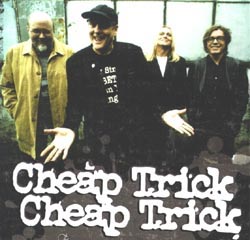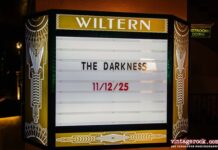Concert Review by Shawn Perry
In late 1978 when I was attending college, I met up with a DJ by the name of Brian. He had a shift at the college radio station, and really thought he had his finger on the pulse of the music scene at the time. We became friends in a way, although I don’t remember much about him or what he even looked like. One thing I do recall is that he was completely over the moon for Cheap Trick. He scored a copy of their live album At Budokan, available only as Japanese import, and played it over and over again, embedding each and every preteen squeal into the collective consciousness of the entire campus — well at least those who listened. Either way, the record took hold. Between the hysteria and displays of adulation — the likes of which had not been seen in Tokyo since the arrival of the Beatles — were irresistible pop rock hooks perpetuated by a chunky edge and heavy backbeat. When you put aside the goofy characterizations, Cheap Trick was and remains about accessible and easy-to-use music.
Two weeks later, I paid $11.99 for the Japanese import of At Budokan at my local Tower Records. Epic Records, in their infinite wisdom, released the album stateside soon after and it raced up the charts. The Rockford, Illinois-based foursome with two slick-and-lick rockers on guitar/vocals and bass, a bowery boy look-alike who wrote most of the tunes and played lead guitar, and a drummer who chain-smoked and dressed like an accountant on drums became the “it” band of the late 70s.
Their distinctive brand of pop rock is both abrasive and harmonious in its assault. Rick Nielsen’s biting guitar work is mildly absolved by Robin Zander’s assured vocals and unassuming rhythm guitar. Drummer Bun E. Carlos and bassist Tom Petersson masterfully corner the pocket, without letting the hinges get too rusty in the aftermath. Thirty years running, the same group of guys is still together, still recording, and still on the road.
The first time I saw Cheap Trick was on New Year’s Eve 1979 at the Long Beach Arena. It was a big deal with the At Budokan record as its centerpiece, and it went down, if I recall correctly, in grand style. Dream Police, the next record, cemented the band’s place in the pantheon of new wavy, power popsters making the rounds. The unmistakable image, the quirky execution and style, the enticing sparkle and hum of the songs carried over to the George Martin-produced album, All Shook Up. Around the same time, Nielson and Carlos did a session with John Lennon, who was gearing up to make a comeback. They recorded “I’m Losing You,” although their version didn’t make the cut for the Double Fantasy album (It would later turn up on the John Lennon Anthology box set). One can only assume that at the beginning of the 80s, things were looking peachy and keen for Cheap Trick.
But in the summer of 1980, Petersson left and the group struggled to carry on, producing a series of albums that failed to live up to expectations. On one special Saturday night in the mid 80s, I saw Cheap Trick play a concert at Disneyland. They were set up on a raft moored to Tom Sawyer’s Island while a gathering throng of Disney tourists looked on from the mainland, alternately waiting in line for the Haunted Mansion and The Pirates Of The Caribbean attractions. A wide body of water stood between the band and the audience, and every time Nielsen attempted to flick his pick to an anxious fan, it fell short and dropped into the drink. I actually felt sorry for Cheap Trick, sensing they were in a slump without any hope of redemption.
Then, in and around 1988, Petersson returned to the fold, discovering that the new band he had attempted to start with his wife wasn’t going to amount to much in the shadow of Cheap Trick. At once, the original foursome was revitalized, recording Lap Of Luxury, a multi-platinum phenomenon featuring “The Flame” and a cover of Elvis Presley’s “Don’t Be Cruel.” House of Lords, a group I worked with, opened a few dates during the Lap Of Luxury tour. I saw Cheap Trick emerge from a funk without missing a beat. I remember seeing them play a triumphant gig on New Year’s Eve 1988 in Chicago, thinking that they were going to be as big as they had been 10 years earlier.
The fact that that didn’t quite happen was of no fault of Cheap Trick’s. By the end of the 80s, they and other bands like them were clinging to a cultural shift, a mutating landscape where the rock dinosaurs of the 60s and 70s were being shown to the door of extinction. Rap and grunge was on every hipster’s mind, and it was difficult for most veteran acts to adapt. Cheap Trick continued releasing albums, touring, and bobbing in the water like a hyperactive Easter egg, but their stock was down and plunging. By the dawn of the new millennium, they’d become a by-product of another generation. But instead of resting of their laurels and playing greatest hits shows, Cheap Trick still had a trick or two under their sleeve. Rockford, their 24th album and first in three years, came to the rescue.

Rockford has enabled Cheap Trick to reconnect with their pop rock roots via an engaging and fresh approach. Hearing the album made me want to see them again — something I hadn’t done in 17 years. So when I read they were appearing at the legendary Wiltern Theatre, I knew I had to see them. Securing a floor seat behind the pit, I marveled at the sight of the four tricksters as they scooted out on the stage and commenced to play.
Nielsen wore his usual cap and cheeky grin, along with a black jacket emblazoned with a skull and crossbones patch on the back. Perhaps he’s put the checkerboard cashmere sweaters away and is trying to roughen up his image. Zander, traditionally known for wearing sharp white suits, is total rock and roll with laced-up trousers, a black Cheap Trick T-shirt, black jacket, and black boots. Petersson was all crushed blue velvet and a white shirt, while a non-smoking Carlos wore the simple ensemble of blue jeans and a black T-shirt. The older, wiser, twisted appearances, depending on who you’re looking at, didn’t deter this tightly wound unit from ripping right into the classics, starting off with “Hello There” and dovetailing into “Big Eyes.”
To honor producer Jack Douglas, in attendance and notable for producing the first Cheap Trick album along with records by Aerosmith and John Lennon, “Oh Candy” was dusted off and pounded into metal. “Welcome To The World,” the opening cut from Rockford, stirred the assembled to life. “Come On, Come On, Come On” and “If It Takes A Lifetime,” two others from Rockford, fit snuggly within the spacious framework of Trick concert staples. For “Best Friend,” from 2003’s Special One CD, the group was joined on stage by guitarist Wayne Kramer of the MC5. The extended jam session was a rare treat amongst the usual three or four minute spurts of joy.
From there, it was all about what Cheap Trick wanted: The unforgettable whine of “I Want You To Want Me” followed by “I Know What I Want,” featuring Petersson on lead vocals and a pounding 12-string bass intro. “The Flame” dutifully ignited the crowd’s enthusiasm before Big Star’s “In The Street,” alternately known as “That ’70s Song,” rang somewhat hollow, largely due to the fact that That 70’s Show, the television program from which the song played a major role, eventually ran out of gas and is presently over syndicated.
Nielsen, known for his large arsenal of guitars, pulled out a five-neck Hamer for the finale “Surrender.” At one point, he tossed a Kiss record out into the audience while strumming what apparently amounts to five guitars in a kinetically awkward manner. For the encore, a sizzling “Dream Police” parted the sea for the punky “Auf Wiedersehen.” Atypical from your usual Cheap Trick ditty, the lyrics end with a call for “Suicide,” while Petersson and Carlos floated to the forefront on their respective instruments and demonstrated their ample worth. A reprise of “Good Night,” i.e., “Hello There,” and the four bounced off stage to cheers of more, more, more. Exiting through a line-up of $10 Cheap Trick T-shirt vendors, I realized I had seen a group relatively unfazed by the passing of time and trends. When all is wrong with the world, there’s always Cheap Trick to turn to.




















